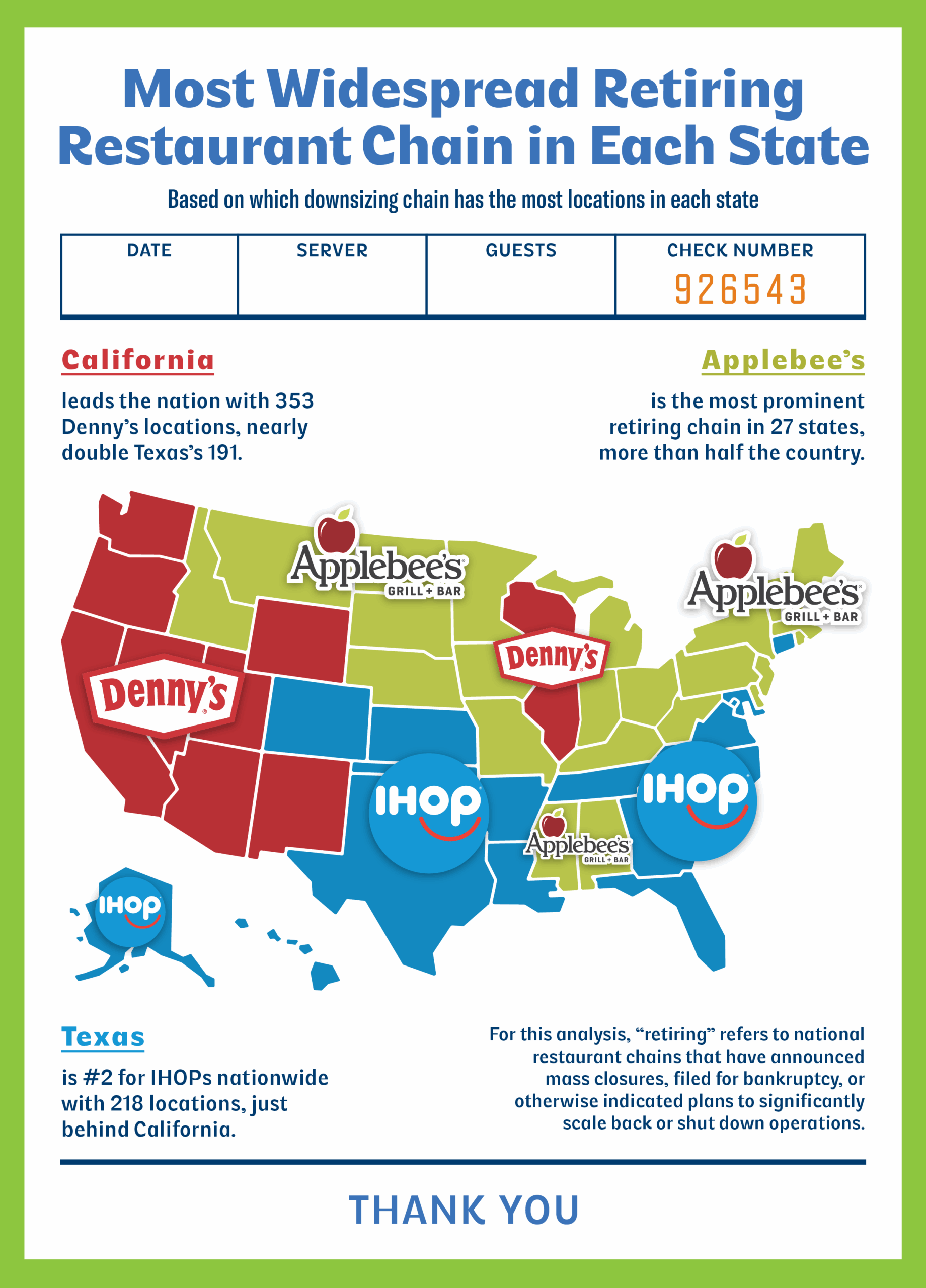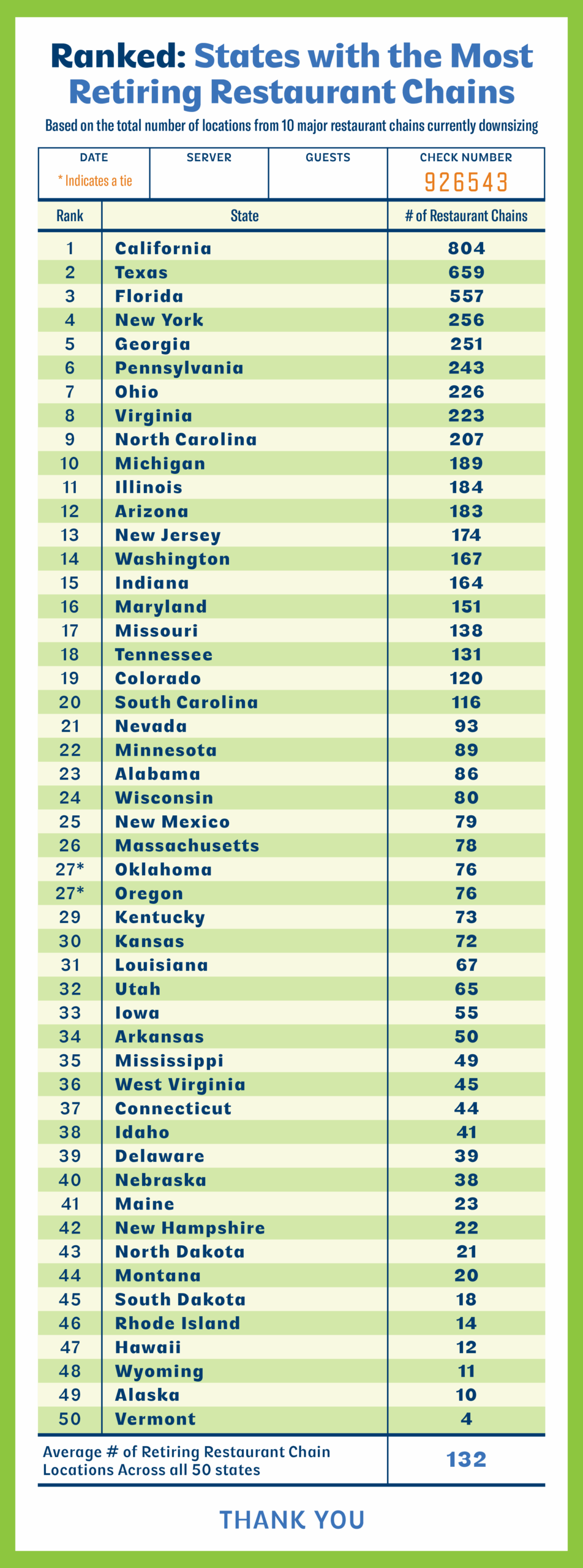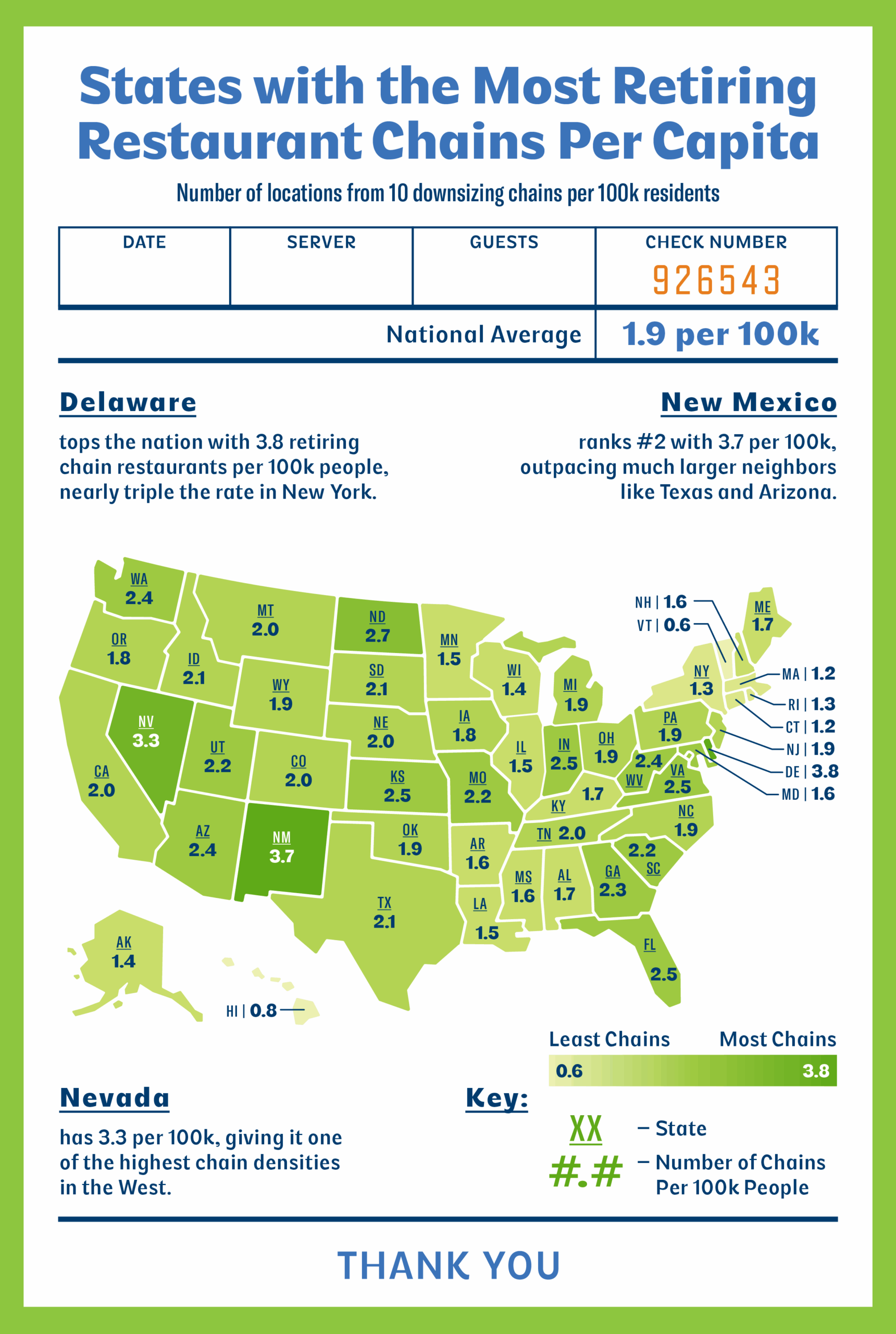
Across the U.S., some of the country’s most recognizable restaurant chains — from TGI Fridays to Red Lobster and Ruby Tuesday — are shrinking their presence after years of being staples of family dinners and casual nights out. These “retiring” brands have announced large-scale downsizing, bankruptcies, or major cutbacks, raising questions about their future availability.
To see where these changes could have the biggest impact, we analyzed location data for 10 major chains currently scaling back operations. This study highlights the states with the largest remaining footprints of these at-risk brands and reveals which chains dominate in each region.
Key Findings
- California leads the nation with 804 locations of these retiring chains.
- Delaware has the highest concentration per capita, with 3.82 retiring chain locations per 100k residents.
- Vermont has the fewest, with just four retiring chain locations statewide.
- Applebee’s is the most widespread retiring chain, ranking No. 1 in 27 states for the most remaining locations.
Most Widespread Retiring Restaurant Chain in Every State

When it comes to downsizing chains, Applebee’s dominates the national landscape, standing out as the most common retiring chain in 27 states — more than half the country.
IHOP has a stronghold in 14 states, particularly across the South and East Coast. Texas alone has 218 IHOP restaurants still operating, which could mean a lot of vacant breakfast options in Texas’s future.
Meanwhile, Denny’s is most concentrated in the West, ranking as the top retiring chain in states including California, Oregon, Nevada, and Washington. California has 353 Denny’s locations, making it the state most likely to be seriously affected by the brand’s decline.
States With the Most Retiring Chain Locations

We also examined total downsizing restaurant counts by state, revealing that some states have a far greater presence of retiring chains than others.
States With the Most Retiring Chain Locations
- California — 804
- Texas — 659
- Florida — 557
- New York — 256
- Georgia — 251
- Pennsylvania — 243
- Ohio — 226
- Virginia — 223
- North Carolina — 207
- Michigan — 189
These figures show that downsizing chains remain most concentrated in the nation’s largest states. California, Florida, and Texas alone account for more than 2,000 locations, underscoring how deeply casual dining chains are embedded in their local food cultures.
Meanwhile, population-heavy states like New York and Pennsylvania continue to rely on these restaurants as a staple of everyday dining, making their shrinking footprints especially notable.
States With the Fewest Retiring Chain Locations
- Vermont — 4
- Alaska — 10
- Wyoming — 11
- Hawaii — 12
- Rhode Island — 14
- South Dakota — 18
- Montana — 20
- North Dakota — 21
- New Hampshire — 22
- Maine — 23
At the other end of the spectrum, rural and less densely populated states see far fewer retiring chain locations in absolute terms. Vermont leads with the smallest number at just four, while states like Alaska and Wyoming also report fewer than a dozen each.
Though the totals are smaller, the impact can still be outsized in these regions, where residents may have fewer dining alternatives and rely more heavily on the limited chain options available.
States With the Highest Density of At-Risk Chain Restaurants

While raw totals highlight where retiring chains have the largest footprints, looking at the data on a per-capita basis tells a different story. In smaller states, even a modest number of locations can translate to a significant share of local dining options.
States With the Highest Density of Retiring Chains
- Delaware — 3.82 per 100,000 people
- New Mexico — 3.73 per 100k people
- Nevada — 3.32 per 100k people
- North Dakota — 2.69 per 100k people
- Virginia — 2.54 per 100k people
- Indiana — 2.50 per 100k people
- Kansas — 2.49 per 100k people
- Florida — 2.45 per 100k people
- West Virginia — 2.43 per 100k people
- Arizona — 2.41 per 100k people
Delaware, New Mexico, and Nevada stand out most, with more than 3 at-risk chain restaurants per 100k residents. These high densities show that even though these states don’t rank among the highest in raw totals, residents there feel a greater impact relative to population.
Meanwhile, populous states like Florida still appear in the top 10, underscoring the scale of downsizing even in regions with plenty of alternatives.
States With the Lowest Density of Retiring Chains
- Vermont — 0.63 per 100k people
- Hawaii — 0.83 per 100k people
- Massachusetts — 1.16 per 100k people
- Connecticut — 1.21 per 100k people
- New York — 1.28 per 100k people
- Rhode Island — 1.33 per 100k people
- Alaska — 1.35 per 100k people
- Wisconsin — 1.35 per 100k people
- Illinois — 1.45 per 100k people
- Louisiana — 1.45 per 100k people
On the other hand, Vermont and Hawaii report the lowest densities, with fewer than 1 at-risk chain locations per 100k residents. Larger states, such as Illinois and New York, also appear in this category, showing that their larger populations help offset the impact.
In these states, the decline of iconic chains may feel less noticeable compared to smaller regions where dining options are already limited.
Closing Thoughts
Across the country, America’s dining scene is shifting, as once-familiar names like Applebee’s, Denny’s, and IHOP fade from communities large and small.
States like California, Texas, and Florida still host hundreds of downsizing chain restaurant locations. If these downsizing trends continue, states with hundreds of locations today could see a noticeable gap in their dining landscapes. On a per-person basis, smaller states like Delaware and New Mexico may feel the impact more acutely.
This analysis of retiring restaurant chains highlights how America’s dining traditions — from casual nights out to family celebrations — continue to evolve.
At Coventry Direct, we understand the importance of preserving what matters most. Just as many families feel the loss of restaurants tied to their memories, individuals with life insurance policies they no longer need may be overlooking a valuable opportunity.
Through a life settlement, policyowners can unlock the hidden value in their policies — turning something they thought might fade away into financial resources that can support their goals or even help them leave a lasting legacy.
If you have a policy you no longer need, contact Coventry Direct today to discover how much it could be worth.
Methodology
To identify where Americans are most affected by the downsizing of restaurant chains, we analyzed location data for 10 major national brands currently scaling back, including TGI Fridays, Red Lobster, and Ruby Tuesday. These “retiring” chains were selected based on a list compiled by Delish, which highlighted restaurants that have announced mass closures, filed for bankruptcy, or significantly reduced operations.
We ranked each U.S. state by the total number of at-risk locations, then adjusted those figures per capita using U.S. Census population estimates. Finally, we identified the most prevalent retiring restaurant chain in each state to highlight regional trends.

